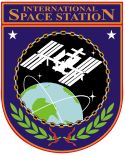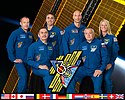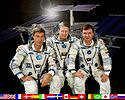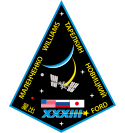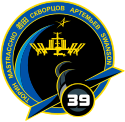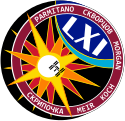Lista ekspedycji na Międzynarodową Stację Kosmiczną
| Ten artykuł od 2017-12 wymaga modyfikacji na podstawie najświeższych informacji. |
Jest to chronologiczna lista ekspedycji na Międzynarodową Stację Kosmiczną. Czas pobytu na ISS jednej stałej załogi wynosi około pół roku (~180 dni). Począwszy od ekspedycji 13 załoganci są dowożeni na stację za pomocą różnych statków co spowodowało, iż czas pobytu na stacji astronautów danej ekspedycji jest różny i przeważnie kosmonauci podczas jednego lotu są członkami dwóch ekspedycji.
Oznaczenia
Członkowie ekspedycji otrzymują następujące rangi (zgodnie z oznaczeniami NASA):
- CDR – (Commander) Dowódca Stacji - w poniższym zestawieniu dowódca każdej ekspedycji został wyróżniony pogrubieniem,
- FE – (Flight Engineer) Inżynier Pokładowy (w przypadku gdy jest kilku inżynierów pokładowych otrzymują oni dodatkowo do oznaczenia numer, np.: FE-1 – pierwszy inż. pokł., FE-2 – drugi inż. pokł., itd).
Występują również inne rangi poboczne (np.: SO – pracownik naukowy), jednak nie zostały one ujęte w poniższym zestawieniu, gdyż są to dodatkowe oznaczenia dopisywane do głównych (np.: FE-1 SO).
Zakończone ekspedycje
| Emblemat ekspedycji | Załoga | Zdjęcie załogi | Start | Lądowanie | Czas pobytu w kosmosie | ||
|---|---|---|---|---|---|---|---|
| Ekspedycja 1 2 listopada 2000 – 19 marca 2001 | |||||||
 |  | 31 października 2000 07:53 UTC Sojuz TM-31 | 21 marca 2001 07:32 UTC Discovery STS-102 | 140 dni, 23 godz. 39 min | |||
| Ekspedycja 2 10 marca – 20 sierpnia 2001 | |||||||
 |  | 8 marca 2001 11:42 UTC Discovery STS-102 | 22 sierpnia 2001 18:23 UTC Discovery STS-105 | 167 dni, 6 godz. 41 min | |||
| Ekspedycja 3 12 sierpnia – 15 grudnia 2001 | |||||||
 | 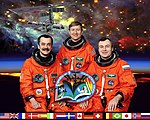 | 10 sierpnia 2001 21:10 UTC Discovery STS-105 | 17 grudnia 2001 17:55 UTC Endeavour STS-108 | 128 dni, 20 godz. 45 min | |||
| Ekspedycja 4 7 grudnia 2001 – 15 czerwca 2002 | |||||||
 |  | 5 grudnia 2001 22:19 UTC Endeavour STS-108 | 19 czerwca 2002 17:58 UTC Endeavour STS-111 | 195 dni, 19 godz. 38 min | |||
| Ekspedycja 5 7 czerwca – 2 grudnia 2002 | |||||||
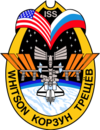 |  | 5 czerwca 2002 21:23 UTC Endeavour STS-111 | 7 grudnia 2002 19:37 UTC Endeavour STS-113 | 184 dni, 22 godz. 14 min | |||
| Ekspedycja 6 25 listopada – 3 maja 2002 | |||||||
 | 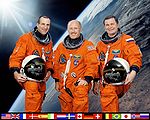 | 24 listopada 2002 00:50 UTC Endeavour STS-113 | 4 maja 2003 02:04 UTC Sojuz TMA-1 | 161 dni, 1 godz. 15 min | |||
| 1 lutego 2003 nastąpiła katastrofa promu kosmicznego Columbia, co spowodowało uziemienie całej floty wahadłowców. W związku z tym postanowiono zmniejszyć liczbę członków załogi do dwóch osób, gdyż loty załogowe na ISS odbywały się tylko za pomocą rosyjskich statków Sojuz. | |||||||
| Ekspedycja 7 28 kwietnia – 27 października 2003 | |||||||
 |  | 26 kwietnia 2003 03:54 UTC Sojuz TMA-2 | 28 października 2003 02:40 UTC Sojuz TMA-2 | 184 dni, 22 godz. 46 min | |||
| Ekspedycja 8 20 października 2003 – 29 kwietnia 2004 | |||||||
 |  | 18 października 2003 05:38 UTC Sojuz TMA-3 | 30 kwietnia 2004 00:12 UTC Sojuz TMA-3 | 194 dni, 18 godz. 34 min | |||
| Ekspedycja 9 21 kwietnia – 23 października 2004 | |||||||
 |  | 19 kwietnia 2004 03:19 UTC Sojuz TMA-4 | 24 października 2004 00:36 UTC Sojuz TMA-4 | 187 dni, 21 godz. 17 min | |||
| Ekspedycja 10 16 października 2004 – 24 kwietnia 2005 | |||||||
 |  | 14 października 2004 03:06 UTC Sojuz TMA-5 | 24 kwietnia 2005 22:07 UTC Sojuz TMA-5 | 192 dni, 19 godz. 1 min | |||
| Ekspedycja 11 17 kwietnia – 10 października 2005 | |||||||
 |  | 15 kwietnia 2005 00:46 UTC Sojuz TMA-6 | 11 października 2005 01:09 UTC Sojuz TMA-6 | 179 dni, 0 godz. 23 min | |||
| Ekspedycja 12 3 października 2005 – 8 kwietnia 2006 | |||||||
 |  | 1 października 2005 03:55 UTC Sojuz TMA-7 | 8 kwietnia 2006 23:47 UTC Sojuz TMA-7 | 189 dni, 19 godz. 52 min | |||
| 26 lipca 2005, startem promu Discovery, wznowiono program lotów promów kosmicznych. Prawie rok później prom Discovery przywiózł na stacje pierwszego europejskiego członka stałej załogi, astronautę ESA Thomasa Reitera. Dzięki temu liczba członków załogi ponownie wzrosła do 3 osób. Dowódcy stacji i pierwsi inżynierowie byli dostarczani za pomocą rosyjskich statków Sojuz, w czasie gdy drudzy inżynierowie pokładowi latali na ISS na pokładzie amerykańskich wahadłowców. | |||||||
| Ekspedycja 13 1 kwietnia – 28 listopada 2006 | |||||||
 |  | 30 marca 2006 02:30 UTC Sojuz TMA-8 | 28 listopada 2006 01:13 UTC Sojuz TMA-8 | 182 dni, 22 godz. 43 min | |||
| 4 lipca 2006 18:38 UTC Discovery STS-121 | przeszedł do Ekspedycji 14 | ||||||
| Ekspedycja 14 20 listopada 2006 – 21 kwietnia 2007 | |||||||
 |  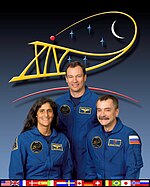 | 18 listopada 2006 04:09 UTC Sojuz TMA-9 | 21 kwietnia 2007 12:31 UTC Sojuz TMA-9 | 215 dni, 8 godz. 23 min | |||
| przeszedł z Ekspedycji 13 | 21 grudnia 2006 22:32 UTC Discovery STS-116 | 171 dni, 3 godz. 54 min | |||||
| 10 grudnia 2006 01:47 UTC Discovery STS-116 | przeszła do Ekspedycji 15 | ||||||
| Ekspedycja 15 9 kwietnia – 21 października 2007 | |||||||
 | 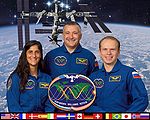  | 7 kwietnia 2007 17:31 UTC Sojuz TMA-10 | 21 października 2007 10:36 UTC Sojuz TMA-10 | 197 dni, 17 godz. 5 min | |||
| przeszła z Ekspedycji 14 | 22 czerwca 2007 19:49 UTC Atlantis STS-117 | 194 dni, 18 godz. 2 min | |||||
| 8 czerwca 2007 23:38 UTC Atlantis STS-117 | przeszedł do Ekspedycji 16 | ||||||
| Ekspedycja 16 12 października 2007 – 19 kwietnia 2008 | |||||||
 |  | 10 października 2007 13:22 UTC Sojuz TMA-11 | 19 kwietnia 2008 08:30 UTC Sojuz TMA-11 | 191 dni, 19 godz. 8 min | |||
| przeszedł z Ekspedycji 15 | 7 listopada 2007 18:01 UTC Discovery STS-120 | 151 dni, 18 godz. 23 min | |||||
| 23 października 2007 15:38 UTC Discovery STS-120 | 20 lutego 2008 14:07 UTC Atlantis STS-122 | 119 dni, 22 godz. 29 min | |||||
| 7 lutego 2008 19:45 UTC Atlantis STS-122 | 27 marca 2008 00:39 UTC Endeavour STS-123 | 48 dni, 4 godz. 54 min | |||||
| 11 marca 2008 06:28 UTC Endeavour STS-123 | przeszedł do Ekspedycji 17 | ||||||
| Ekspedycja 17 10 kwietnia 2008 – 24 października 2008 | |||||||
 |  | 8 kwietnia 2008 11:16 UTC Sojuz TMA-12 | 24 października 2008 03:37 UTC Sojuz TMA-12 | 198 dni, 16 godz. 21 min | |||
| przeszedł z Ekspedycji 16 | 14 czerwca 2008 15:15 UTC Discovery STS-124 | 95 dni, 7 godz. 47 min | |||||
| 31 maja 2008 21:02 UTC Discovery STS-124 | przeszedł do Ekspedycji 18 | ||||||
| Ekspedycja 18 14 października 2008 – 8 kwietnia 2009 | |||||||
 | 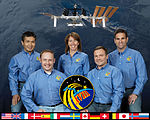 | 12 października 2008 07:02 UTC Sojuz TMA-13 | 8 kwietnia 2009 7:16 UTC Sojuz TMA-13 | 178 dni, 0 godz. 14 min | |||
| przeszedł z Ekspedycji 17 | 30 listopada 2008 21:25 UTC Endeavour STS-126 | 183 dni, 0 godz. 23 min | |||||
| 15 listopada 2008 00:55 UTC Endeavour >STS-126 | 28 marca 2009 19:13 UTC Discovery STS-119 | 133 dni, 18 godz. 18 min | |||||
| 15 marca 2009 23:43 UTC Discovery STS-119 | przeszedł do Ekspedycji 19 | ||||||
| Ekspedycja 19 28 marca – 29 maja 2009 | |||||||
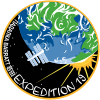 |  | 26 marca 2009 11:49 UTC Sojuz TMA-14 | przeszli do Ekspedycji 20 | ||||
| przeszedł z Ekspedycji 18 | |||||||
| Począwszy od maja 2009 r. stała załoga stacji liczy 6 osób. W związku z tym do stacji przycumowane są przez cały czas dwa statki Sojuz dające całej załodze możliwość ewakuacji w razie niebezpieczeństwa. Co kilka miesięcy część załogi jest wymieniana, zatem zmieniali się również dowódcy stacji oraz numeracja inżynierów pokładowych. Powodowało to sytuacje, w której każdy z członków danej załogi był lub będzie członkiem innej. Większość załogantów przyleciało na stacje na pokładzie Sojuzów, ale część była dowożona również wahadłowcami. | |||||||
| Ekspedycja 20 29 maja – 11 października 2009 | |||||||
 |  | przeszli z Ekspedycji 19 | 11 października 2009 4:32 UTC Sojuz TMA-14 | 198 dni, 16 godz. 43 min | |||
| 31 lipca 2009 16:48 UTC Endeavour STS-127 | 137 dni, 15 godz. 4 min | ||||||
| 27 maja 2009 10:34 UTC Sojuz TMA-15 | przeszli do Ekspedycji 21 | ||||||
| 15 lipca 2009 22:03 UTC Endeavour STS-127 | 12 września 2009 0:53 UTC Discovery STS-128 | 58 dni, 2 godz. 50 min | |||||
| 29 sierpnia 2009 3:59 UTC Discovery STS-128 | przeszła do Ekspedycji 21 | ||||||
| Ekspedycja 21 11 października – 1 grudnia 2009 | |||||||
 |  | przeszli z Ekspedycji 20 | 1 grudnia 2009 7:16 UTC Sojuz TMA-15 | 187 dni, 20 godz. 41 min | |||
| 27 listopada 2009 14:44 UTC Atlantis STS-129 | 90 dni, 10 godz. 45 min | ||||||
| 30 września 2009 7:15 UTC Sojuz TMA-16 | przeszli do Ekspedycji 22 | ||||||
| Ekspedycja 22 1 grudnia 2009 – 18 marca 2010 | |||||||
 | 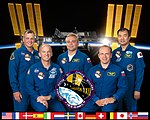 | przeszli z Ekspedycji 21 | 18 marca 2010 11:24 UTC Sojuz TMA-16 | 169 dni, 4 godz. 10 min | |||
| 20 grudnia 2009 21:52 UTC Sojuz TMA-17 | przeszli do Ekspedycji 23 | ||||||
| Ekspedycja 23 18 marca – 2 czerwca 2010 | |||||||
 |  | przeszli z Ekspedycji 22 | 2 czerwca 2010 03:24 UTC Sojuz TMA-17 | 163 dni, 5 godz. 32 min | |||
| 2 kwietnia 2010 04:05 UTC Sojuz TMA-18 | przeszli do Ekspedycji 24 | ||||||
| Ekspedycja 24 2 czerwca – 25 września 2010 | |||||||
 |  | przeszli z Ekspedycji 23 | 25 września 2010 05:23 UTC Sojuz TMA-18 | 176 dni, 1 godz. 18 min | |||
| 15 czerwca 2010 21:25 Sojuz TMA-19 | przeszli do Ekspedycji 25 | ||||||
| Ekspedycja 25 25 września – 26 listopada 2010 | |||||||
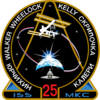 |  | przeszli z Ekspedycji 24 | 26 listopada 2010 04:46 UTC Sojuz TMA-19 | 163 dni, 7 godz. 10 min | |||
| 7 października 2010 23:10 UTC Sojuz TMA-01M | przeszli do Ekspedycji 26 | ||||||
| Ekspedycja 26 26 listopada 2010 – 16 marca 2011 | |||||||
 |  | przeszli z Ekspedycji 25 | 16 marca 2011 07:54 UTC Sojuz TMA-01M | 159 dni, 8 godz. 43 min | |||
| 15 grudnia 2010 19:09 UTC Sojuz TMA-20 | przeszli do Ekspedycji 27 | ||||||
| Ekspedycja 27 16 marca – 24 maja 2011 | |||||||
 | 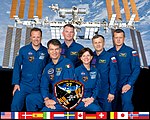 | przeszli z Ekspedycji 26 | 24 maja 2011 02:26 UTC Sojuz TMA-20 | 159 dni, 7 godz. 17 min | |||
| 4 kwietnia 2011 22:18 UTC Sojuz TMA-21 | przeszli do Ekspedycji 28 | ||||||
| Ekspedycja 28 24 maja – 16 września 2011 | |||||||
 | 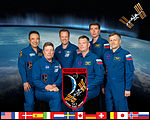 | przeszli z Ekspedycji 27 | 16 września 2011 03:59 UTC Sojuz TMA-21 | 164 dni, 5 godz. 41 min | |||
| 7 czerwca 2011 20:12 UTC Sojuz TMA-02M | przeszli do Ekspedycji 29 | ||||||
| Ekspedycja 29 16 września – 22 listopada 2011 | |||||||
 |  | przeszli z Ekspedycji 28 | 22 listopada 2011 02:24 UTC Sojuz TMA-02M | 167 dni, 6 godz. 12 min | |||
| 14 listopada 2011 04:22 UTC Sojuz TMA-22 | przeszli do Ekspedycji 30 | ||||||
| Ekspedycja 30 22 listopada 2011 – 27 kwietnia 2012 | |||||||
 | 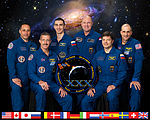 | przeszli z Ekspedycji 29 | 27 kwietnia 2012 11:45 UTC Sojuz TMA-22 | 165 dni, 7 godz. 31 min | |||
| 21 grudnia 2011 13:16 UTC Sojuz TMA-03M | przeszli do Ekspedycji 31 | ||||||
| Ekspedycja 31 27 kwietnia 2012 – 1 lipca 2012 | |||||||
 |  | przeszli z Ekspedycji 30 | 1 lipca 2012 08:14 UTC Sojuz TMA-03M | 192 dni, 18 godz. 58 min | |||
| 15 maja 2012 03:01 UTC Sojuz TMA-04M | przeszli do Ekspedycji 32 | ||||||
| Ekspedycja 32 1 lipca – 17 września 2012 | |||||||
 |  | przeszli z Ekspedycji 31 | 17 września 2012 02:52 UTC Sojuz TMA-04M | 124 dni, 23 godz. 51 min | |||
| 15 lipca 2012 02:40 UTC Sojuz TMA-05M | przeszli do Ekspedycji 33 | ||||||
| Ekspedycja 33 17 września – 19 listopada 2012 | |||||||
 | 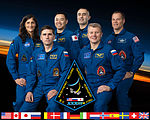 | przeszli z Ekspedycji 32 | 19 listopada 2012 01:53 UTC Sojuz TMA-05M | 126 dni, 23 godz. 13 min | |||
| 23 października 2012 10:51 UTC Sojuz TMA-06M | przeszli do Ekspedycji 34 | ||||||
| Ekspedycja 34 19 listopada 2012 – 16 marca 2013 | |||||||
 |  | przeszli z Ekspedycji 33 | 16 marca 2013 03:06 UTC Sojuz TMA-06M | 143 dni, 16 godz. 15 min | |||
| 19 grudnia 2012 12:12 UTC Sojuz TMA-07M | przeszli do Ekspedycji 35 | ||||||
| Ekspedycja 35 16 marca – 14 maja 2013 | |||||||
 |  | przeszli z Ekspedycji 34 | 14 maja 2013 02:30 UTC Sojuz TMA-07M | 145 dni, 14 godz. 18 min | |||
| 28 marca 2013 20:43 UTC Sojuz TMA-08M | przeszli do Ekspedycji 36 | ||||||
| Ekspedycja 36 14 maja – 11 września 2013 | |||||||
 |  | przeszli z Ekspedycji 35 | 11 września 2013 02:58 UTC Sojuz TMA-08M | 166 dni, 6 godz. 15 min | |||
| 28 maja 2013 20:31 UTC Sojuz TMA-09M | przeszli do Ekspedycji 37 | ||||||
| Ekspedycja 37 11 września – 11 listopada 2013 | |||||||
 |  | przeszli z Ekspedycji 36 | 11 listopada 2013 02:49 UTC Sojuz TMA-09M | 166 dni, 6 godz. 17 min | |||
| 25 września 2013 20:58 UTC Sojuz TMA-10M | przeszli do Ekspedycji 38 | ||||||
| Ekspedycja 38 11 listopada 2013 – 11 marca 2014 | |||||||
 |  | przeszli z Ekspedycji 37 | 11 marca 2014 03:23 UTC Sojuz TMA-10M | 166 dni, 6 godz. 25 min | |||
| 7 listopada 2013 04:14 UTC Sojuz TMA-11M | przeszli do Ekspedycji 39 | ||||||
| Ekspedycja 39 11 marca 2014 – 13 maja 2014 | |||||||
 |  | przeszli z Ekspedycji 38 | 14 maja 2014 01:58 UTC Sojuz TMA-11M | 187 dni, 21 godz. 44 min | |||
| 25 marca 2014 21:17 UTC Sojuz TMA-12M | przeszli do Ekspedycji 40 | ||||||
| Ekspedycja 40 13 maja 2014 – 10 wrzesinia 2014 | |||||||
 |  | przeszli z Ekspedycji 39 | 11 września 2014 02:23 UTC Sojuz TMA-12M | 169 dni, 5 godz. 6 min | |||
| 28 maja 2014 19:57 UTC Sojuz TMA-13M | przeszli do Ekspedycji 41 | ||||||
| Ekspedycja 41 10 września 2014 – 10 listopada 2014 | |||||||
 |  | przeszli z Ekspedycji 40 | 10 listopada 2014 03:58 UTC Sojuz TMA-13M | 165 dni, 8 godz. 1 min | |||
| 25 września 2014 20:25 UTC Sojuz TMA-14M | przeszli do Ekspedycji 42 | ||||||
| Ekspedycja 42 10 listopada 2014 – 11 marca 2015 | |||||||
 |  | przeszli z Ekspedycji 41 | 12 marca 2015 02:07 UTC Sojuz TMA-14M | 167 dni, 5 godz. 43 min | |||
| 23 listopada 2014 21:01 UTC Sojuz TMA-15M | przeszli do Ekspedycji 43 | ||||||
| Ekspedycja 43 11 marca 2015 – 11 czerwca 2015 | |||||||
 |  | przeszli z Ekspedycji 42 | 11 czerwca 2015 13:44 UTC Sojuz TMA-15M | 199 dni, 16 godz. 43 min | |||
| 27 marca 2015 19:42 UTC Sojuz TMA-16M | przeszli do Ekspedycji 44 | ||||||
| Ekspedycja 44 11 czerwca 2015 - 11 września 2015 | |||||||
 | 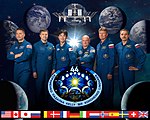 | przeszeszli z Ekspedycji 43 | 12 września 2015 00:51 UTC Sojuz TMA-16M | 168 dni, 5 godz. 8 min | |||
| przeszli do Ekspedycji 45 | |||||||
| 22 czerwca 2015 21:02 UTC Sojuz TMA-17M | |||||||
| Ekspedycja 45 11 września 2015 - 11 grudnia 2015 | |||||||
 |  | przeszeszli z Ekspedycji 44 | przeszli do Ekspedycji 46 | ||||
| 11 grudnia 2015 13:12 UTC Sojuz TMA-17M | 171 dni, 16 godz. 5 min | ||||||
| 2 września 2015 04:37 UTC Sojuz TMA-18M | przeszedł do Ekspedycji 46 | ||||||
| Ekspedycja 46 11 grudnia 2015 - 2 marca 2016 | |||||||
 |  | przeszli z Ekspedycji 45 | 2 marca 2016 04:25 UTC Sojuz TMA-18M | 340 dni, 8 godz. 43 min | |||
| 181 dni, 23 godz. 47 min | |||||||
| 15 grudnia 2015 11:03 UTC Sojuz TMA-19M | przeszli do Ekspedycji 47 | ||||||
| Ekspedycja 47 2 marca 2016 - 18 czerwca 2016 | |||||||
 |  | przeszli z Ekspedycji 46 | 18 czerwca 2016 11:03 UTC Sojuz TMA-19M | 185 dni, 22 godz. 12 min | |||
| 18 marca 2016 21:26 UTC Sojuz TMA-20M | przeszli do Ekspedycji 48 | ||||||
| Ekspedycja 48 18 czerwca 2016 - 6 września 2016 | |||||||
 | 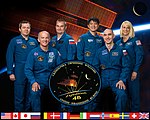 | przeszli z Ekspedycji 47 | 7 września 2016 01:13 Sojuz TMA-20M | 172 dni, 3 godz. 47 min | |||
| 7 lipca 2016 01:36 UTC Sojuz MS-01 | przeszli do Ekspedycji 49 | ||||||
| Ekspedycja 49 6 września 2016 - 30 października 2016 | |||||||
 |  | przeszli z Ekspedycji 48 | 30 października 2016 03:59 UTC Sojuz MS-01 | 115 dni, 2 godz. 22 min | |||
| 19 października 2016 08:05 UTC Sojuz MS-02 | przeszli do Ekspedycji 50 | ||||||
| Ekspedycja 50 30 października 2016 - 10 kwietnia 2017 | |||||||
 |  | przeszli z Ekspedycji 49 | 10 kwietnia 2017 11:20 UTC Sojuz MS-02 | 173 dni, 3 godz. 16 min | |||
| 17 listopada 2016 20:17 UTC Sojuz MS-03 | przeszli do Ekspedycji 51 | ||||||
| Ekspedycja 51 10 kwietnia 2017 - 2 czerwca 2017 | |||||||
 |  | przeszli z Ekspedycji 50 | przeszła do Ekspedycji 52 | ||||
| 2 czerwca 2017 14:10 UTC Sojuz MS-03 | 196 dni, 17 godz. 49 mint | ||||||
| 20 kwietnia 2017 07:13 UTC Sojuz MS-04 | przeszli do Ekspedycji 52 | ||||||
| Ekspedycja 52 2 czerwca 2017 - 3 września 2017 | |||||||
 |  | przeszli z Ekspedycji 51 | 3 września 2017 01:22 UTC Sojuz MS-04 | 135 dni, 18 godz. 8 min | |||
| 289 dni, 5 godz. 2 min | |||||||
| 28 lipca 2017 15:41 UTC Sojuz MS-05 | przeszli do Ekspedycji 53 | ||||||
| Ekspedycja 53 12 września 2017 - 14 grudnia 2017 | |||||||
 |  | przeszli z Ekspedycji 52 | 14 grudnia 2017 08:38 UTC Sojuz MS-05 | 138 dni, 16 godz. 57 min | |||
| 12 września 2017 21:17 UTC Sojuz MS-06 | przeszli do Ekspedycji 53 | ||||||
| Ekspedycja 54 17 grudnia 2017 - 27 lutego 2018 | |||||||
 | 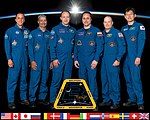 | przeszli z Ekspedycji 53 | 28 lutego 2018 02:31 UTC Sojuz MS-06 | 168 dni, 5 godz. 14 min | |||
| 17 grudnia 2017 07:21 UTC Sojuz MS-07 | przeszli do Ekspedycji 55 | ||||||
| Ekspedycja 55 27 lutego 2018 - 3 czerwca 2018 | |||||||
 |  | przeszli z Ekspedycji 54 | 3 czerwca 2018 12:39 UTC Sojuz MS-07 | 168 dni, 5 godz. 19 min | |||
| 21 marca 2018 17:44 UTC Sojuz MS-08 | przeszli do Ekspedycji 56 | ||||||
| Ekspedycja 56 3 czerwca 2018 - 4 października 2018 | |||||||
 |  | przeszli z Ekspedycji 55 | 4 października 2018 11:44:45 UTC Sojuz MS-08 | 196 dni, 18 godz. 0 min | |||
| 6 czerwca 2018 11:12 UTC Sojuz MS-09 | przeszli do Ekspedycji 56 | ||||||
| Ekspedycja 57 4 października 2018 - 20 grudnia 2018 | |||||||
 |  | przeszli z Ekspedycji 56 | 20 grudnia 2018 05:02 UTC Sojuz MS-09 | 196 dni, 17 godz. 49 min | |||
| 3 grudnia 2018 11:31 UTC Sojuz MS-11 | przeszli do Ekspedycji 58 | ||||||
| Ekspedycja 58 20 grudnia 2018 2018 - 15 marca 2019 | |||||||
 |  | przeszli z Ekspedycji 57 | przeszli do Ekspedycji 59 | ||||
| Ekspedycja 59 15 marca 2019 - 24 czerwca 2019 | |||||||
 |  | przeszli z Ekspedycji 58 | 25 czerwca 2019 02:47:50 UTC Sojuz MS-11 | 203 dni, 15 godz. 16 min | |||
| 14 marca 2019 19:14 UTC Sojuz MS-12 | przeszli do Ekspedycji 60 | ||||||
| Ekspedycja 60 24 czerwca 2019 - 3 października 2019 | |||||||
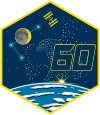 |  | przeszli z Ekspedycji 59 | 3 października 2019 10:59 UTC Sojuz MS-12 | 202 dni, 15 godz. 45 min | |||
| przeszli do Ekspedycji 61 | |||||||
| 20 lipca 2019 16:28:21 UTC Sojuz MS-13 | |||||||
| Ekspedycja 61 3 października 2019 - 6 lutego 2020 | |||||||
 |  | przeszli z Ekspedycji 60 | 6 lutego 2020 09:13 UTC Sojuz MS-13 | 200 dni, 16 godz. 44 min | |||
| 328 dni, 13 godz. 59 min | |||||||
| przeszli do Ekspedycji 62 | |||||||
| 25 września 2019 13:57:43 UTC Sojuz MS-15 | |||||||
| Ekspedycja 62 6 lutego 2020 - 17 kwietnia 2020 | |||||||
 |  | przeszli z Ekspedycji 61 | 17 kwietnia 2020 05:16 UTC Sojuz MS-15 | 204 dni, 15 godz. 19 min | |||
| 271 dni, 12 godz. 48 min | |||||||
| 9 kwietnia 2020 Sojuz MS-16 | przeszli do Ekspedycji 63 | ||||||
| Emblemat ekspedycji | Załoga | Zdjęcie załogi | Start | Lądowanie | Czas pobytu w kosmosie | ||
Trwająca ekspedycja
| Emblemat ekspedycji | Załoga | Zdjęcie załogi | Start | Lądowanie |
|---|---|---|---|---|
| Ekspedycja 63 17 kwietnia 2020 - 21 października 2020 (wg planu) | ||||
 |  | przeszli z Ekspedycji 62 | 21 października 2020 (wg planu) Sojuz MS-16 | |
(nie są członkami ekspedycji 63 ale przebywali na MSK w trakcie Ekspedycji 63) | 30 maja 2020(SpaceX DM-2) | 2 sierpnia 2020 | ||
| 30 października 2020 (wg planu) UCSV-1 | przejdą do Ekspedycji 64 | |||
| 14 października 2020 (wg planu) Sojuz MS-17 | ||||
Przyszłe ekspedycje
Podane w poniższym zestawieniu daty są terminami planowanymi i mogą ulec zmianie.
| Emblemat ekspedycji | Załoga | Start | Lądowanie | |
|---|---|---|---|---|
| Ekspedycja 64 21 października 2020 - kwiecień 2021 | ||||
| przejdą z Ekspedycji 63 | 18 kwietnia 2021 (wg planu) Sojuz MS-17 | |||
| przejdą do Ekspedycji 65 | ||||
Zobacz też
- Międzynarodowa Stacja Kosmiczna
- program lotów wahadłowców
- program Sojuz
- lista bezzałogowych lotów kosmicznych do Międzynarodowej Stacji Kosmicznej
- lista gości Międzynarodowej Stacji Kosmicznej
- etapy montażu Międzynarodowej Stacji Kosmicznej
Linki zewnętrzne
- Międzynarodowa Stacja Kosmiczna. spaceflight.nasa.gov. [zarchiwizowane z tego adresu (2011-02-24)]. (ang.)
- Przyszłe Ekspedycje na ISS (niem.)
- Ekspedycje na ISS (ang.)
- Wykaz stałych załóg ISS na "Loty kosmiczne" (pol.)
Media użyte na tej stronie
An outdated clock with a serious icon
The flag of Navassa Island is simply the United States flag. It does not have a "local" flag or "unofficial" flag; it is an uninhabited island. The version with a profile view was based on Flags of the World and as a fictional design has no status warranting a place on any Wiki. It was made up by a random person with no connection to the island, it has never flown on the island, and it has never received any sort of recognition or validation by any authority. The person quoted on that page has no authority to bestow a flag, "unofficial" or otherwise, on the island.
The Expedition 52 crew insignia
- Our planet is shown surrounded by an imaginary constellation shaped like a house, depicting the theme of the patch: “The Earth is our home.” It is our precious cradle, to be preserved for all future generations. The house of stars just touches the Moon, acknowledging the first steps we have already taken there, while Mars is not far away, just beyond the International Space Station, symbolized by the Roman numeral “LII,” signifying the expedition number.
- The planets Saturn and Jupiter, seen orbiting farther away, symbolize humanity’s exploration of deeper space, which will begin soon. A small Sputnik is seen circling the Earth on the same orbit with the ISS, bridging the beginning of our cosmic quest till now: Expedition 52 will launch in 2017, sixty years after that first satellite.
- Two groups of crew names signify the pair of Soyuz vehicles that will launch the astronauts of Expedition 52 to the Station.
The Expedition 52 crew members (front row, from left) are Commander Fyodor Yurchikhin and NASA astronaut Randy Bresnik. In the back row (from left) are, NASA astronauts Jack Fischer and Peggy Whitson, European Space Agency astronaut Paolo Nespoli and Roscosmos cosmonaut Sergey Ryazanskiy.
ISS016-S-001A (February 2007) --- This patch commemorates the sixteenth expeditionary mission to the International Space Station (ISS). The design represents the conjunction of two unique astronomical events: a transit of the ISS across the surface of a full moon, and a nearly complete annular eclipse of the sun. The ISS is shown in its complete configuration, symbolizing the role of this expedition in preparing for the arrival and commissioning of international partner modules and components. The ISS transit across the moon highlights its role in developing the techniques and innovations critical to enable long-duration expeditions to the lunar surface and beyond. The NASA insignia design for shuttle and space station flights is reserved for use by the astronauts and for other official use as the NASA Administrator may authorize. Public availability has been approved only in the form of illustrations by the various news media. When and if there is any change in this policy, which is not anticipated, it will be publicly announced.
Expedition 36 crew members take a break from training at NASA's Johnson Space Center to pose for a crew portrait. Pictured on the front row are Russian cosmonauts Pavel Vinogradov (left), commander; and Fyodor Yurchikhin, flight engineer. Pictured from the left (back row) are Russian cosmonaut Alexander Misurkin, NASA astronaut Chris Cassidy, European Space Agency astronaut Luca Parmitano and NASA astronaut Karen Nyberg, all flight engineers.
Expedition 20 crewmembers take a break from training at NASA's Johnson Space Center to pose for a crew portrait. From the left (front row) are European Space Agency astronaut Frank De Winne, Expedition 20 flight engineer and Expedition 21 commander; cosmonaut Gennady Padalka, Expedition 19/20 commander; and cosmonaut Roman Romanenko, Expedition 20/21 flight engineer. From the left (back row) are Canadian Space Agency astronaut Robert Thirsk, Expedition 20/21 flight engineer; NASA astronauts Michael Barratt, Expedition 19/20 flight engineer; Nicole Stott, Expedition 20/21 flight engineer; Tim Kopra, Expedition 20 flight engineer; and Japan Aerospace Exploration Agency (JAXA) astronaut Koichi Wakata, 18/19/20 flight engineer.
The Expedition 59 crew insignia
- The Expedition 59 patch celebrates the International Space Station’s role as a microgravity science laboratory. The crew, made up of scientists, doctors, engineers and pilots, will conduct hundreds of experiments for the benefit of mankind and our fragile environment on planet Earth.
- The patch shape depicts the cupola windows. Through these windows, astronauts have made many significant observations of Earth’s ecosystems and they have discovered and documented real-time events like volcanic eruptions and earthquakes.
- The position of the Earth at the top of the patch depicts where the Earth would be seen by an astronaut from the cupola. It represents the explorers’ unique perspective on his or her home. The image at the center of the patch is the station itself, the largest single structure humans have ever put into space, an engineering marvel.
- The station is overlaid on an atom, the basic building block of all matter. The atom has three electron orbits with the flags of Russia, the United States of America and Canada, representing the home countries of the Expedition 59 crew. Like electrons in an atom, international cooperation is the basic stabilizing force that enables large scale space exploration.
- To achieve great deeds, humans from all across the globe must work together in peace with a shared vision. The Expedition 59 patch celebrates the massive scientific accomplishments of the space station while highlighting the importance of global teamwork in understanding our planet and continuing with bold exploration in the future.
The Expedition 54 crew insignia
- Orbiting Earth continuously since 1998, the International Space Station (ISS) is one of our greatest engineering achievements. It is depicted in gold, symbolic of constancy and excellence. Flying toward a sunrise represents the station’s contributions to a bright future. That sunrise uses blue, white, and red, the combined national colors of Japan, Russia, and the United States, symbolizing the crew’s cohesiveness. Crewmember names are in blue, symbolizing devotion and loyalty.
- The gold border represents the constant human presence in space onboard the orbiting laboratory. Symbolic of new Russian and U.S. spacecraft that will advance human exploration, the patch is shaped as a capsule. The number 54 is drawn as a path eventually leading to Mars.
- Finally, the stars symbolize the values of leadership, trust, teamwork, and excellence lived by mission control teams throughout the history of human space programs, as well as the global vigilance of those teams while operating the station.
The Expedition 41 crew members have released their patch and have written some text to go along with it:
- "Portraying the road of human exploration into our vastly unknown universe, all elements of the Expedition 41 patch build from the foundation, our Earth, to the stars beyond our solar system. The focus of our six-month expedition to the International Space Station (ISS) is Earth and its inhabitants as well as a scientific look out into our universe. The distinguishing ISS solar arrays reach onward and serve as the central element, with the icon of an atom underneath representing the multitude of research onboard that will bring new discoveries for the benefit of humanity. The sun is rising over Earth's horizon, spreading its light along the road of human exploration. Equipped with the knowledge and inspiration gained from ISS, our successful multinational cooperation will lead human space exploration to the moon, Mars, and ultimately, the stars. We are Expedition 41. Join us for the adventure."
The official Expedition 61 crew portrait with (from left) NASA astronaut Andrew Morgan, Roscosmos cosmonaut Alexander Skvortsov, astronaut Luca Parmitano of ESA (European Space Agency), Roscosmos cosmonaut Oleg Skripochka, and NASA astronauts Jessica Meir and Christina Koch.
ISS003-S-002 (June 2001) --- Taking a break from a busy training schedule to pose for a portrait are the crew members for Expedition Three, scheduled to replace the current cosmonaut/astronaut trio aboard the International Space Station (ISS). Astronaut Frank L. Culbertson, Jr. (center), commander, is flanked by cosmonauts Mikhail Tyurin (left) and Vladimir Dezhurov, both flight engineers representing Rosaviakosmos. The three will accompany the STS-105 crew into Earth orbit aboard the Space Shuttle Discovery this summer to begin their lengthy stay on the orbital outpost.
ISS014-S-002A (30 March 2006) --- Astronaut Michael E. Lopez-Alegria (center), Expedition 14 commander and NASA space station science officer; cosmonaut Mikhail Tyurin (right), flight engineer representing Russia's Federal Space Agency; and astronaut Sunita L. Williams, flight engineer, take a break from training at Johnson Space Center to pose for a crew portrait.
The mission patch design for the 25th Expedition to the International Space Station (ISS) pays tribute to the rich history of innovation and bold engineering in the quest for knowledge, exploration and discovery in space. The patch highlights the symbolic passing of the torch to the ISS, as the vehicle that will carry us into the future of space exploration. The Space Shuttle Program emblem is the foundation of the patch and forms the Greek letter 'Alpha' with a new dawn breaking at the center, symbolizing a new vision for space exploration. The Alpha symbol is overlaid by the Greek letter 'Omega', paying tribute to the culmination of the Space Shuttle Program. The mission designation '25' is shown centered at the bottom of the patch, symbolizing the point in time when the Space Shuttle, the workhorse of the ISS assembly process, will make its final visit to the ISS. Between the '25' and the Earth crescent, the orbiter is shown returning to Earth on its final journey, during the Expedition 25 mission. Above Earth and the breaking dawn, the ISS takes center-stage, completed and fully equipped to carry us beyond this new dawn to new voyages and discoveries. The orbit connecting the ISS and the Earth is drawn in the colors of the United States and Russian flags; paying tribute to the blended heritage of the crew. The two largest stars in the field represent the arrival and departure of the crews in separate Russian Soyuz vehicles. The six stars in the field represent the six crew members. The International Space Station abbreviation 'ISS' and 'MKC' - in English and Russian, respectively - flank the mission number designation, and the names of the crew members in their native languages border the ISS symbol.
Expedition 39 crew members take a break from training at NASA's Johnson Space Center to pose for a crew portrait. Pictured on the front row are Japan Aerospace Exploration Agency (JAXA) astronaut Koichi Wakata (right), commander; and NASA astronaut Steve Swanson, flight engineer. Pictured from the left (back row) are Russian cosmonauts Oleg Artemyev, Alexander Skvortsov, Mikhail Tyurin and NASA astronaut Rick Mastracchio, all flight engineers.
The crew members of the Expedition 34 mission put together the following description of their patch: "The outer border of the Expedition 34 patch takes the mold line of a crew transfer or generic resupply vehicle which will form our bridge to the orbiting outpost throughout the second half of its operational lifetime. Inscribed inside in gold is a craft symbolizing future extra-terrestrial landers that will someday open other celestial destinations to human exploration. Our Sun, which enables the miracle of the only known life in our universe, radiates above the rich and colorful orb of Earth. Its 15 rays represent the countries of the International Space Station (ISS) Partnership whose foresight and sacrifice have enabled the first small steps into our universe. The ISS in flight represents the dedication, ingenuity, and cooperation amongst the thousands and thousands of workers around the globe who have successfully designed and built a wonder of our modern world. The distant stars, like those visible in our night sky, beckon us to come further into the depths of space. 'Off the Earth. . . For the Earth' - Our acknowledgement of the responsibility and commitment to work diligently for all inhabitants of planet Earth."
The Expedition 17 patch is meant to celebrate current human achievements in space as well as symbolize the future potential for continuing exploration. The Earth, represented at the bottom of the patch, is the base from which all space exploration activities initiate. The International Space Station (ISS), shown in low Earth orbit, illustrates the current level of space operations. The arrow and star point outwards, away from the Earth, towards the wider universe indicating the direction of future activities as human beings build on what has already been accomplished. The flags, representing the home countries of the crew members, Russia and the United States, are touching, highlighting the cooperative nature of the space program and symbolizing the merger of science and technical knowledge of these two experienced space-faring nations.
Crew of ISS Expedition 1 launched with Soyuz TM-31
ISS Expedition One Commander William M. (Bill) Shepherd (center) is flanked by Soyuz Commander Yuri P. Gidzenko (right) and Flight Engineer Sergei K. Krikalev (left) in this crew photograph, taken during a break in training in Russia. The three, posed in front of a rendition of the International Space Station, are wearing the Sokol space suits like those they will don for their Soyuz-provided trip to ISS later this month. National flags representing all the international partners run along the bottom of the portrait.
The Expedition 20 patch symbolizes a new era in space exploration with the first six-person crew living and working onboard ISS and represents the significance of the ISS to the exploration goals of NASA and its international partners. The six gold stars signify the men and women of the crew. The astronaut symbol extends from the base of the patch to the star at the top to represent the international team, both on the ground and on orbit, that are working together to further our knowledge of living and working in space. The space station in the foreground represents where we are now and the important role it is playing towards meeting our exploration goals. The knowledge and expertise developed from these advancements will enable us to once again leave low earth orbit for the new challenges of establishing a permanent presence on the moon and then on to Mars. The blue, gray and red arcs represent our exploration goals as symbols of Earth, the moon and Mars.
The six-member Expedition 55 crew poses for an official crew portrait at the Johnson Space Center in Houston, Texas. In the front row (from left) are Scott Tingle of NASA, Commander Anton Shkaplerov of Roscosmos and Norishige Kanai of the Japan Aerospace Exploration Agency. In the back row (from left) are NASA astronauts Ricky Arnold and Andrew Feustel and Roscosmos cosmonaut Oleg Artemyev.
Expedition 60 crew poster
Expedition 28 crew members take a break from training at NASA's Johnson Space Center to pose for a crew portrait. Pictured from the right (front row) are Russian cosmonaut Andre Borisenko, commander; Russian cosmonaut Alexander Samokutyaev and NASA astronaut Mike Fossum, both flight engineers. Pictured from the left (back row) are Japan Aerospace Exploration Agency (JAXA) astronaut Satoshi Furukawa, NASA astronaut Ron Garan and Russian cosmonaut Sergei Volkov, all flight engineers.
International Space Station during Expedition 16. Astronaut Peggy Whitson (front row, right), station commander; and Russia's Federal Space Agency cosmonaut Yuri Malenchenko (front row, left), flight engineer and Soyuz commander, NASA astronaut Clay Anderson (back row, left), flight engineer, astronaut Dan Tani (back row, second from left), flight engineer, Leopold Eyharts of the European Space Agency (back row, third from left), astronaut Garrett Reisman (back row, far right), flight engineer.
ISS Expedition 5 insignia ISS005-S-001 (January 2002) -- The International Space Station (ISS) Expedition Five patch depicts the Station in its completed configuration and represents the vision of mankind's first step as a permanent human presence in space. The United States and Russian flags are joined together in a Roman numeral V to represent both the nationalities of the crew and the fifth crew to live aboard the ISS. Crew members’ names are shown in the border of this patch. This increment encompasses a new phase in growth for the Station, with three Shuttle crews delivering critical components and building blocks to the ISS. To signify the participation of each crew member, the Shuttle is docked to the Station beneath a constellation of 17 stars symbolizing all those visiting and living aboard Station during this increment. The NASA insignia design for Shuttle flights and Station increments is reserved for use by the astronauts and for other official use as the NASA Administrator may authorize. Public availability has been approved only in the forms of illustrations by the various news media. When and if there is any change in this policy, which is not anticipated, the change will be publicly announced.
The official Expedition crew portrait with (from left) NASA astronaut Anne McClain, Roscosmos cosmonaut Oleg Kononenko and astronaut David Saint-Jacques of the Canadian Space Agency.
Expedition 41 crew members take a break from training at NASA's Johnson Space Center to pose for a crew portrait. Pictured on the front row are Russian cosmonaut Maxim Suraev (left), commander; and NASA astronaut Barry Wilmore, flight engineer. Pictured from the left (back row) are NASA astronaut Reid Wiseman, European Space Agency astronaut Alexander Gerst, Russian cosmonauts Alexander Samokutyaev and Elena Serova, all flight engineers.
The Expedition 53 crew insignia
- The International Space Station is our launch pad into the future of human space exploration. Collectively, our world stands at the cusp of incredible developments as a spacefaring species. Onboard the space station we continue to evolve the technologies vital to the sustainment and longevity of humans in the harsh realities of living without gravity or the protection of our atmosphere. These self-sustaining or regenerative technologies continually developed aboard the space station not only improve life here on Earth, but they are essential to human beings existence beyond low-Earth orbit (LEO).
- The space station is the linchpin for this next great phase of development and is instrumental in expanding the use of space, not only as a worldclass science laboratory, but also as a destination for next-generation space vehicles. This journey beyond LEO is depicted in the Expedition 53 patch as we, the crew, will endeavor to accomplish the work that allows future missions to further explore our solar system. This journey will only be accomplished as an international team, represented by our multinational crew as well as by the many countries depicted on the globe.
- The myriad of stars represent the untold number of passionate and supremely dedicated people that endeavor across the planet daily to make the space station the amazing vehicle it is as well as prepare us for the next great steps forward in space exploration.
Expedition 15 commander Fyodor Yurchikhin (center), flight engineer Oleg Kotov (right), and flight engineer Sunita Williams pose for a crew portrait
Expedition 33 crew members take a break from training at NASA's Johnson Space Center to pose for a crew portrait. Pictured from the left are NASA astronaut Sunita Williams, commander; along with Russian cosmonaut Yuri Malenchenko, Japan Aerospace Exploration Agency (JAXA) astronaut Akihiko Hoshide, Russian cosmonaut Evgeny Tarelkin, Russian cosmonaut Oleg Novitskiy and NASA astronaut Kevin Ford, all flight engineers.
The Expedition 10 patch uses simple symbolism to describe the mission. The large Roman numeral "X," formed by the American and Russian flags, symbolizes the joint nature of this mission, as well as the fact that this flight is the 10th mission to stay on the International Space Station (ISS). The current configuration of the ISS is next to the name of the ISS Commander, while the Soyuz vehicle is placed next to the name of the Soyuz Commander. The single star and the black background signify this is a space mission.
Expedition 48 crew portrait with 46S crew (Jeff Williams, Oleg Skripochka, Aleksei Ovchinin) and 47S crew (Anatoli Ivanishin, Kate Rubins, Takuya Onishi).
The six-member Expedition 54 crew poses for an official crew portrait at the Johnson Space Center in Houston, Texas. From left are Flight Engineers Joe Acaba and Mark Vande Hei of NASA, Commander Alexander Misurkin of Roscosmos and Flight Engineers Anton Shkaplerov of Roscosmos, Scott Tingle of NASA and Norishige Kanai of the Japan Aerospace Exploration Agency.
Astronaut Edward M. (Mike) Fincke (left), Expedition 9 NASA ISS science officer and flight engineer, and cosmonaut Gennady I. Padalka, commander, pose for their crew portrait while in training at the Gagarin Cosmonaut Training Center in Star City, Russia for their scheduled launch in the spring of this year in a Soyuz TMA-4 spacecraft. Padalka represents the Federal Space Agency.
Expedition 21 will be the 21st long duration mission on-board the International Space Station (ISS) and the second to include six crew members.
- The central element of the patch is inspired by a fractal of six, symbolizing the teamwork of the six-person crew. From the basic element of one person, together six people form a much more complex and multifaceted entity, toward the infinity of the universe. The patch shows children, on Earth in the bright Sun, as our future and the reason we explore. The Soyuz and Shuttle are the vehicles that enable human space exploration today, while the International Space Station is leading to our next goals, the moon and Mars. The patch shape has six tips, geometrically sound yet reminiscent of a leaf, representing symmetry and ecological harmony, while the six stars in deep space represent the current crew and future exploration crews.
NASA astronauts Greg Chamitoff (left), Garrett Reisman, both Expedition 17 flight engineers; Russian Federal Space Agency cosmonauts Sergei Volkov, commander; and Oleg Kononenko, flight engineer, take a break from training at NASA's Johnson Space Center to pose for a portrait. Reisman will launch to the International Space Station on the STS-123 mission of Endeavour in March 2008, joining Expedition 16 in progress and will provide Expedition 17 with an experienced flight engineer for the first part of its increment. Volkov and Kononenko are scheduled to launch to the complex in the Soyuz TMA-12 spacecraft from the Baikonur Cosmodrome in Kazakhstan in April for a six-month mission. Chamitoff is scheduled to launch to the station on the STS-124 mission of Discovery in June, joining Expedition 17 in progress.
Official crew Patch of Expedition 50 on the International Space Station.
- The Expedition 50 patch encompasses the spirit of human exploration from previous missions to the moon to current exploration on the International Space Station (ISS). The red border symbolizes future human exploration of Mars – the Red Planet. Our home planet Earth is prominent in the patch to remind us that everything done on the mission is to help people on Earth – “Off the Earth, For the Earth.” The background colors of red, white, and blue represent the national colors of all six crew members – United States, Russia, and France. The six stars represent the families of all six crewmembers. Finally, the numeral 50 signifies the 50th Expedition to the ISS.
Expedition 19 marks the final planned period of three person occupancy, prior to increasing the crew size to 6, and occurs in the final stages of International Space Station assembly. The patch emphasizes the earth, one of the major focuses of attention and study from the orbital research outpost. The design is stylized to highlight the beauty of the home planet and the station orbiting it, next to the sun now the unquestioned 'brightest star in the sky' as viewed from earth.
ISS Expedition 47 Insignia
- The central depiction of the International Space Station (ISS) is in recognition of the international achievement of designing, building and maintaining a world-class space laboratory. The orientation of the ISS represents the view seen by the Soyuz crewmembers as they approach the station. The blackness of space in the background portrays the limitless area that humankind has yet to explore.
- The efforts of the Expedition 47 crew will contribute to the growing body of knowledge and expertise that will allow us to extend human exploration beyond low-Earth orbit. The three blue colors are from the flags of the Expedition 47 crew’s home countries (United States, Russia and the United Kingdom), representing a fundamental commonality among each of the international partner countries whom the crewmembers serve.
Emblazoned with a bold 35 for the 35th expedition to the International Space Station (ISS), this patch portrays a natural moonlit view of the Earth from the ISS at the moment of sunrise, one of the sixteen that occur each day at orbital velocity, with glowing bands of Earth's atmosphere dispersing the sun's bright light into primary colors. The Earth is depicted as it often appears from space, without recognizable coastlines or boundaries - just as the international endeavor of living and working together in space blurs technical and cultural boundaries between nations. The ISS is the unseen central figure of the image, since the view is from a window of the Space Station itself, commemorating full use of the Space Station as a long-duration dwelling from which humans can develop techniques and technologies to further explore. The crew points out, "The arc of the Earth's horizon with the sun's arrows of light imply a bow shooting the imagination to Mars and the cosmos where our species may one day thrive."
The 46 icon in the foreground of the Expedition 46 patch represents the forty-sixth expeditionary mission to the International Space Station. The graphic portrays the limb of the home planet, Earth, with the black vastness of space in the background. Earth is depicted at the top with the flags of the countries of origin of the crew members: the United States of America, Russia and the United Kingdom. The flag of the U.K. is displayed in a position of prominence in recognition of the significance of the first British astronaut flown in space for the European Space Agency. The outer border is in the shape of a triangle with an unbroken border, symbolizing the infinite journey of discovery for past, present and future space explorers. The names of the six Expedition 46 astronauts and cosmonauts are shown in the border.
The official portrait of the Expedition 56 crew. In the front row from left are astronauts Drew Feustel of NASA and Alexander Gerst of the European Space Agency. In the rear from left are crew members Oleg Artemyev of Roscosmos, Ricky Arnold of NASA, Sergei Prokopev of Roscosmos and Serena Auñón-Chancellor of NASA.
Thin crescents along the horizons of Earth and its moon depict International Space Station (ISS) Expedition 31. The shape of the patch represents a view of our galaxy. The black background symbolizes the research into dark matter, one of the scientific objectives of Expedition 31. At the heart of the patch are Earth, its moon, Mars, and asteroids, the focus of current and future exploration. The ISS is shown in an orbit around Earth, with a collection of stars for the Expedition 30 and 31 crews. The small stars symbolize the visiting vehicles that will dock with the complex during this expedition.
The Expedition 12 patch represents both mankind's permanent presence in space and future dreams of exploration. The International Space Station (ISS), featured prominently in the center, will continue to grow in its capability as a world-class laboratory and test bed for exploration. The vision of exploration is depicted by the moon and Mars. The star symbolizes mankind's destiny in space and is a tribute to the space explorers who have been lost in its pursuit. The Roman numeral XII in the background signifies the 12th expeditionary mission to the ISS.
Expedition 34 crew members take a break from training at NASA's Johnson Space Center to pose for a crew portrait. Pictured on the front row are NASA astronaut Kevin Ford (left), commander; and Canadian Space Agency astronaut Chris Hadfield, flight engineer. Pictured from the left (back row) are Russian cosmonauts Oleg Novitskiy, Evgeny Tarelkin, Roman Romanenko and NASA astronaut Tom Marshburn, all flight engineers.
Astronaut Michael E. Lopez-Alegria (center), Expedition 14 commander and NASA space station science officer; cosmonaut Mikhail Tyurin (right), flight engineer representing Russia's Federal Space Agency; and European Space Agency (ESA) astronaut Thomas Reiter, flight engineer, take a break from training at Johnson Space Center to pose for a crew portrait.
The new Expedition 63 crew joined the Expedition 62 crew today a board the International Space Station. (Front row from left) NASA astronaut Chris Cassidy and Roscosmos cosmonauts Anatoly Ivanishin and Ivan Vagner. (Back row from left) NASA astronaut Andrew Morgan, Roscosmos cosmonaut Oleg Skripochka and NASA astronaut Jessica Meir.
The six Expedition 40 crew members take a break from training to pose for their crew portrait. From left are cosmonaut Alexander Skvortsov of Roscosmos, NASA astronaut Steve Swanson and cosmonaut Oleg Artemyev; ESA astronaut Alexander Gerst, cosmonaut Maxim Suraev and NASA astronaut Reid Wiseman. The 38S crew is composed of Swanson, Skvortsov and Artemyev. The 39S crew includes Suraev, Gerst and Wiseman.
Expedition 21 crew members take a break from training at NASA's Johnson Space Center to pose for a crew portrait. Pictured on the front row are European Space Agency astronaut Frank De Winne (center), commander; NASA astronaut Nicole Stott and Russian cosmonaut Roman Romanenko, both flight engineers. Pictured on the back row (from the left) are Russian cosmonaut Maxim Suraev, NASA astronaut Jeffrey Williams and Canadian Space Agency astronaut Robert Thirsk, all flight engineers.
The official Expedition 59 crew portrait with (from left) astronauts David Saint-Jacques of the Canadian Space Agency and Anne McClain of NASA; cosmonauts Oleg Kononenko and Aleksey Ovchinin of Roscosmos; and NASA astronauts Nick Hague and Christina Koch.
Official crew patch of Expedition 51 during their mission to the International Space.
- From as early as the 11th century, coats of arms have been used as emblems representing groups as small as families to as large as countries. The Expedition 51 patch is designed as a modernized international coat of arms, blending the traditional shield shape with our modernized symbol of achievement, the International Space Station. The background represents our home world and its inhabitants on the left, and outer space to the right. The bi-color International Space Station is the bridge between the two, symbolizing the benefits on Earth of space research, and at the same time our mission to explore deeper into space, on a path to further discovery and knowledge.
Equipage de l'expédition 19 vers l'ISS.
ISS019-S-002 --- Cosmonaut Gennady Padalka (center), Expedition 19 commander; NASA astronaut Michael Barratt (left) and Japan Aerospace Exploration Agency (JAXA) astronaut Koichi Wakata, both flight engineers, take a break from training at NASA's Johnson Space Center to pose for a crew portrait. Padalka and Barratt are scheduled to launch to the International Space Station in the Soyuz TMA-14 spacecraft from the Baikonur Cosmodrome in Kazakhstan in March 2009. Wakata will fly to the station on STS-119 and will serve as a flight engineer for Expeditions 18 and 19.SpaceX DM-2 Crew Poster
ISS Expedition 38 Patch
As the International Space Station (ISS) has become a stepping stone to future space exploration, the Expedition 38 mission patch design paints a visual roadmap of exploration beyond low Earth orbit, most prominently represented by the design's flowing Expedition 38 mission numbers that wrap around Earth, the moon and Mars. Just as the sun is a guiding light in the galaxy, the ISS illuminates the bottom of the design as it is a shining beacon of the advancement of science, knowledge, and technology carried out aboard the Space Station. To visually capture the idea of the ISS being a foundation for infinite discovery, the space station's iconic solar arrays span upwards, providing the number 38 and its exploration roadmap a symbolic pedestal to rest on. Finally, the overall use of red, white, and blue in the design acknowledges the flags of the countries of origin for Expedition 38's crew -- the United States, Russia, and Japan.
The Expedition 33 patch depicts the International Space Station (ISS) orbiting around the Earth, and into the future. The national flags of Japan, Russia, and the United States of America represent the crew of Expedition 33, which consists of six astronauts and cosmonauts from Japan, Russia and the United States. The five white stars represent the partners participating in the ISS Program – Canada, European countries, Japan, Russia and the United States. Expedition 33 will continue the work of the previous thirty-two expedition crews on board the multi-national laboratory in areas such as biology and biotechnology, earth and space science, educational activities, human research, physical and material sciences, and technology development and demonstration.
Expedition 45 crew portrait with (from left) Commander Scott Kelly and Flight Engineers Sergey Volkov, Mikhail Kornienko, Kjell Lindgren, Oleg Kononenko and Kimiya Yui.
ISS Expedition 39 Patch
Increment 39 of the International Space Station Program marks the 15th year of operation since the start of the space laboratory assembly. Today, the U.S., Russia, Japan, Canada and the European Space Agency are partnering in the operation of the largest ever orbital outpost managed by humankind. The names of the six crew members are depicted in their native languages. For Expedition 39, the Soyuz spacecraft serves as transport vehicle for the crew members to and from the station. During this expedition, the ISS will serve as a platform for scientific research, Earth and astronomical observation, education, as well as a stage for the development of new technologies used for the exploration beyond low Earth orbit. The star above the complex signifies human space exploration towards new frontiers. The crew members added these words: "The crew of Expedition 39 is proud to serve the international community in furthering our scientific knowledge and in expanding human presence in space."
Expedition 26 crew members take a break from training at NASA's Johnson Space Center to pose for a crew portrait. Pictured clockwise from the right are NASA astronaut Scott Kelly, commander; NASA astronaut Catherine Coleman, Russian cosmonauts Dmitry Kondratyev, Oleg Skripochka, Alexander Kaleri and European Space Agency (ESA) astronaut Paolo Nespoli, all flight engineers.
Official Expedition 47 crew portrait with 45S crew (Yuri Malenchenko/Tim Kopra/Tim Peake) and the 46S crew (Jeff Williams, Oleg Skripochka, Aleksei Ovchinin)
Expedition 23 crew members. From the left are Russian cosmonaut Mikhail Kornienko, NASA astronaut Tracy Caldwell Dyson, Russian cosmonaut Alexander Skvortsov, all flight engineers; Russian cosmonaut Oleg Kotov, commander; NASA astronaut T.J. Creamer and Japan Aerospace Exploration Agency (JAXA) astronaut Soichi Noguchi, both flight engineers.
Expedition 38 crew members take a break from training at NASA's Johnson Space Center to pose for a crew portrait. Pictured on the front row are Koichi Wakata (left), flight engineer; and Russian cosmonaut Oleg Kotov, commander. Pictured from the left (back row) are Russian cosmonaut Mikhail Tyurin, NASA astronaut Rick Mastracchio, Russian cosmonaut Sergey Ryazanskiy and NASA astronaut Michael Hopkins, all flight engineers.
The Expedition 40 patch depicts the past, present, and future of human space exploration. The crew wrote the description that follows: The reliable and proven Soyuz, our ride to the International Space Station (ISS), is a part of the past, present, and future. The ISS is the culmination of an enormous effort by many countries partnering to produce a first-class orbiting laboratory, and its image represents the current state of space exploration. The ISS is immensely significant to us as our home away from home and our oasis in the sky. The commercial cargo vehicle is also part of the current human space exploration and is a link to the future. A blend of legacy and future technologies is being used to create the next spacecrafts which will carry humans from our planet to destinations beyond. The sun on Earth's horizon represents the new achievements and technologies that will come about due to our continued effort in space exploration.
Expedition 31 crew members take a break from training at NASA's Johnson Space Center to pose for a crew portrait. Pictured on the front row are Russian cosmonauts Oleg Kononenko (right), commander; and Gennady Padalka, flight engineer. Pictured from the left (back row) are NASA astronaut Joe Acaba, Russian cosmonaut Sergei Revin, European Space Agency astronaut Andre Kuipers and NASA astronaut Don Pettit, all flight engineers.
Background was inspired by Van Gogh's "Starry Night".
The crewmembers for Expedition 10 take a break from training in the United States, Russia and other venues to pose for their crew portrait. Astronaut Leroy Chiao, left, is commander and NASA ISS science officer. Cosmonaut Salizhan S. Sharipov, representing Russia’s Federal Space Agency, is flight engineer.
The Expedition 49 crew insignia
This patch commemorates the thirteenth expeditionary mission to the International Space Station (ISS) which continues the permanent human presence in space. The ISS is depicted in its configuration at the start of the six-month expedition with trailing elements from the country flags representing each of the three crew members.
- The crew members made the following statement about their patch: "The dynamic trajectory of the space station against the background of the Earth, Mars, and the Moon symbolizes the vision for human space exploration beyond Earth orbit and the critical role that the ISS plays in the fulfillment of that vision."
In the foreground of the patch, the International Space Station is prominently displayed to acknowledge the efforts of the entire International Space Station (ISS) team - both the crews who have built and operated it, and the team of scientists, engineers, and support personnel on Earth who have provided a foundation for each successful mission. Their efforts and accomplishments have demonstrated the space station's capabilities as a technology test bed and a science laboratory, as well as a path to the human exploration of our solar system and beyond. The ISS is shown with the European Space Agency's (ESA) Automated Transfer Vehicle (ATV-2), the Johannes Kepler, docked to resupply it with experiments, food, water, and fuel for Expedition 26 and beyond. This Expedition 26 patch represents the teamwork among the international partners - USA, Russia, Japan, Canada, and the ESA - and the ongoing commitment from each partner to build, improve, and utilize the ISS. Prominently displayed in the background is our home planet, Earth - the focus of much of our exploration and research on our outpost in space. The two stars symbolize two Soyuz spacecraft, each one carrying a three-member crew, who for four months will work and live together aboard the ISS as Expedition 26. The patch shows the crewmembers' names, and it's framed with the flags of their countries of origin - United States, Russia, and Italy.
The official Expedition 63 crew portrait. From left are, NASA astronaut and Commander Chris Cassidy and Roscosmos cosmonauts and Flight Engineers Anatoly Ivanishin and Ivan Vagner.
The International Space Station (ISS) Expedition Four crew patch has an overall diamond shape, showing the "diamond in the rough" configuration of the Station during expedition four. The red hexagonal shape with stylized American and Russian flags represents the cross-sectional view of the S0 truss segment, which the crew will attach to the U.S. Lab Destiny. The persistent Sun shining on the Earth and Station represents the constant challenges that the crew and ground support team will face every day while operating the International Space Station, while shedding new light through daily research. The green portion of the Earth represents the fourth color in the visible spectrum and the black void of space represents humankind's constant quest to explore the unknown.
The Expedition 56 crew insignia
- The Expedition 56 astronaut crew will continue the international collaborative work that has been evolving on the International Space Station during the past 17 years. The expedition comes at a time when private corporations and the governments around the world are rapidly developing crew capabilities for human space exploration. Together, with the experience and continued research on the orbiting laboratory, humans will soon establish a new presence in space beyond low-Earth orbit that will enable us to travel farther into space than ever before.
- The Expedition 56 patch portrays a dove carrying an olive branch on its beak. The patch includes images of the Soyuz launch vehicle for the crew and the space station. The Expedition 56 astronauts’ names are displayed on the dove’s wings and along the limb of Earth at the base of the patch.
- The dove's tail is firmly planted on Earth to represent the strong link between our home planet and the humans who are sent into the cosmos. The patch illustrates our hope for peace and love in the world, and the innate human desire to spread our wings and explore into the future, building on the wisdom of the past, for the betterment of humanity. The patch was designed by astronaut Drew Feustel's son.
The hexagon (six-sided) shape of the Expedition 43 patch represents the six crew members living and working onboard the orbital outpost. The International Space Station (ISS) is portrayed in orbit around the Earth, representing the multi-national partnership that has constructed, developed, and continues to operate the ISS for the benefit of all humankind. The sunrise marks the beginning of a new day, reflecting the fact that we're at the dawn of our history as a space faring species. The moon and planets represent future exploration of our solar system, for which the ISS is a stepping stone. Finally, the five stars honor the crews who have lost their lives during the pursuit of human spaceflight.
Expedition 18 crewmembers take a break from training at NASA's Johnson Space Center to pose for a group portrait. From the left (front row) are NASA astronaut Michael Fincke and Russian Federal Space Agency cosmonaut Yury Lonchakov, commander and flight engineer, respectively. From the left (back row) are Japan Aerospace Exploration Agency astronaut Koichi Wakata, NASA astronauts Sandra Magnus and Greg Chamitoff, all flight engineers. Chamitoff will launch to the International Space Station (ISS) on the STS-124 mission, joining Expedition 17 in progress and will provide Expedition 18 with an experienced flight engineer for the first part of its increment. Fincke and Lonchakov are scheduled to launch to the station in the Soyuz TMA-13 spacecraft from the Baikonur Cosmodrome in Kazakhstan in October for a six-month mission. Magnus is scheduled to join Expedition 18, replacing Chamitoff, as flight engineer after launching to the ISS on mission STS-126. Wakata is scheduled to join Expedition 18, replacing Magnus, as flight engineer after launching to the orbital complex on mission STS-119.
This emblem embodies the past, present, and future of human space exploration. The Roman numeral XIV suspended above the Earth against the black background of space symbolizes the fourteenth expeditionary mission to the International Space Station (ISS), or Международная Космическая Станция. Elements of this symbol merge into a unified trajectory destined for the moon, Mars, and beyond, much as science and operations aboard the ISS today will pave the way for future missions to our celestial neighbors. The five stars honor the astronauts and cosmonauts of missions Apollo 1, Soyuz 1, Soyuz 11, Challenger, and Columbia, who gave their lives in the pursuit of knowledge and discovery.
The International Space Station (ISS) program is completing the transition from assembly to full utilization as humankind celebrates the golden anniversary of human space exploration. In recognition of these milestones and especially of the contribution of those whose dedication and ingenuity make spaceflight possible, a fully assembled ISS is depicted rising above a sunlit Earth limb. Eastward of the sunlit limb, the distinctive portrayal of Earth's surface illuminated by nighttime city lights is a reminder of mankind's presence on the planet, most readily apparent from space only by night, and commemorates how human beings have transcended their early bonds throughout the previous 50 years of space exploration. The ISS, a unique space-based outpost for research in biological, physical, space and Earth sciences, in the words of the crew members, is an impressive testament to the tremendous teamwork of the engineers, scientists and technicians from 15 countries and five national space agencies. The six crew members of Expedition 30, like those who have gone before them, express that they are honored to represent their countries and the ISS team in conducting research aboard the station and adding to the body of knowledge that will enable the world's space faring countries to more safely and more productively live, work and explore outer space, paving the way for future missions beyond low Earth orbit, and inspiring young people to join in this great adventure.
ISS Expedition 18 patch
This emblem represents the eighteenth expedition to the International Space Station (ISS). Featured prominently is the Roman numeral XVIII. The "X" evokes exploration, which is at the core of the indivisible cooperation of the International Space Station partners. "V" is for victory and for the five space agencies in the ISS program. "III" stands for the hope that this crew will help evolve the ISS from supporting the last three-person crew to crews of six explorers and researchers. The moon, sun and stars symbolize the efforts of the entire ISS team, which will lead to the human exploration of the moon, our solar system and beyond.
The five-member Expedition 51 crew consists of (from left) Jack Fischer, Fyodor Yurchikhin, Thomas Pesquet, Peggy Whitson and Oleg Novitskiy.
Expedition 25 crew members take a break from training at NASA's Johnson Space Center to pose for a crew portrait. Pictured at center right is NASA astronaut Doug Wheelock, commander. Also pictured (from the left) are Russian cosmonauts Oleg Skripochka and Alexander Kaleri; NASA astronauts Scott Kelly and Shannon Walker; along with Russian cosmonaut Fyodor Yurchikhin, all flight engineers.
The portrait's background is a photograph of the M78 nebula and its reflecting dust clouds in the constellation Orion as captured by astrophotographer Ignacio de la Cueva Torregrosa.
Expedition 22 crew members. From the left (front row) are NASA astronaut Jeffrey Williams, commander; and Russian cosmonaut Oleg Kotov, flight engineer. From the left (back row) are NASA astronaut T.J. Creamer, Russian cosmonaut Maxim Suraev and Japan Aerospace Exploration Agency (JAXA) astronaut Soichi Noguchi, all flight engineers.
Expedition 37 crew members take a break from training at NASA's Johnson Space Center to pose for a crew portrait. Pictured on the front row are Russian cosmonauts Fyodor Yurchikhin (left), commander; and Oleg Kotov, flight engineer. Pictured from the left (back row) are NASA astronaut Karen Nyberg, European Space Agency astronaut Luca Parmitano, NASA astronaut Michael Hopkins and Russian cosmonaut Sergey Ryazanskiy, all flight engineers.
The Expedition 60 crew insignia
- The Moon landing is one of the most extraordinary feats of humankind, an embodiment of ingenuity and desire for exploration. The patch of Expedition 60 commemorates the 50th anniversary of that landing: a constellation of three stars with the Moon superimposed forms the letter “L,” the Latin symbol for 50. The Moon is depicted as a waxing crescent, as it was on July 20, 1969.
- The familiar silhouette of the International Space Station is visible, flying across the night sky. Stars, numerous and bright as seen from the space station, form the shape of an eagle in the same pose as on the iconic patch of the Apollo 11 mission. The sunrise represents the fact that we are still in the early stages of humanity’s exploration of space.
- The hexagonal shape of the patch represents the space station's cupola, with the six points of the hexagon symbolizing the six crewmembers of Expedition 60. The names and nationalities are not present, as on the original Apollo 11 mission patch, to highlight that space missions – then, now, and in the future – are for Earth and all humankind.
The official insignia for the three-member Expedition 58 crew with Anne McClain of NASA, Oleg Kononenko of Roscosmos and David Saint-Jacques of the Canadian Space Agency.
- Thousands of people worldwide dedicate their lives to the human exploration of space. As one team, we strive to learn, discover and pioneer for the benefit of all mankind. The Expedition 58 patch is a crew tribute to those thousands who stand ready every day committed to supporting this mission.
- Central to the patch is the compass rose—a symbol of exploration past, present and future. The passing of the International Space Station from darkness into light suggests that we are only just peaking over the horizon, looking forward to advancing human understanding of our place in the universe.
- The crew of Expedition 58 are fortunate explorers … never alone in their journey. Among the night lights on the Earth are glints of brightness – the global team and major control facilities that keep the space station on orbit and its inhabitants on track.
- And as the explorers from centuries past used stars to guide their way, so too does the crew of Expedition 58. The stars on the Expedition 58 patch are their families, one star for each member. They shine on as a beacon of strength and a guiding light home.
The first International Space Station crew patch is a simplified graphic of the station complex when fully completed. The station is seen with solar arrays turned forward. The last names of the Expedition One crew, Soyuz pilot Yuri Gidzenko, flight engineer Sergei Krikalev, and expedition commander William (Bill) Shepherd, appear under the station symbol.
The official insignia of the Expedition 62 crew
- The Expedition 62 patch embodies two main themes: first, the importance of the global partnership on which the International Space Station was founded, and second, the paradigm shifting perspective provided by seeing our planet Earth from above with human eyes. Based on a vintage mosaic found near the headquarters of the Gagarin Cosmonaut Training Center, the two space explorers flying in formation represent friendship between space agencies and the people that work in them. The shining star in the hand is a symbol of unity under a common quest for discovery, as this partnership continues to burn bright into the future.
- Generated by the flying astronauts, the shock wave signifies the powerful impact of human space exploration and the scientific research conducted on the space station, strengthened when we work as a team, side by side with all of our international partners. The backdrop of the large sun behind our planet Earth reminds us that we are but a very small component of our solar system and our universe. The sun is also responsible for fueling life on Earth, sustaining the biosphere (symbolized by the leaf) surrounded by the precious, fragile atmosphere (represented by the clouds).
- This imagery reminds us of our duty to protect our home planet, to preserve our environment and to carry principles of responsible environmental stewardship with us as we explore the universe. This birch leaf combines the principal elements, embodying nature, science and the global alliance, as these trees are indigenous to regions that crewmembers from all sides call home.
Expedition 32 crew members take a break from training at NASA's Johnson Space Center to pose for a crew portrait. Pictured from the left are Japan Aerospace Exploration Agency (JAXA) astronaut Akihiko Hoshide, Russian cosmonaut Yuri Malenchenko, NASA astronaut Sunita Williams, NASA astronaut Joe Acaba, all flight engineers; Russian cosmonaut Gennady Padalka, commander; and Russian cosmonaut Sergei Revin, flight engineer.
The operational teamwork between human space flight controllers and the on-orbit crew take center stage in this emblem. Against a backdrop familiar to all flight controllers, past and present, independent of any nationality, the fifteenth expedition to the ISS is represented in Roman numeral form as part of the ground track traces emblazoned on the Mercator projection of the home planet Earth. The ISS, shown in its fully operational, assembly complete configuration, unfurls and then reunites the flags of this Russian and American crew in a show of our continuing international cooperation. Golden spheres placed strategically on the ground track near the flight control centers of the United States and Russia serve to symbolize both the joint efforts from each nation's team of flight controllers and the shuttle and Soyuz crew vehicles in their chase orbit as they rendezvous with the ISS. A rising sun provides a classic touch to the emblem signifying the perpetual nature of manned space flight operations and their origin in these two space-faring nations.
The International Space Station (ISS) Expedition Seven patch consists of two elliptical orbits which evoke the histories of the two space programs from which the crew is drawn. The Russian and American flags are intersecting, representing the peaceful cooperation of the many countries contributing to the ISS. Two stars indicate the Station's goals of contributing to life on Earth through science and commerce.
Expedition 50 official crew portrait with (from left) Andrei Borisenko, Shane Kimbrough, Sergei Ryzhikov, Thomas Pesquet, Peggy Whitson and Oleg Novitsky.
The six-member Expedition 53 crew poses for an official crew portrait at the Johnson Space Center in Houston, Texas. Seated in the front (from left) are Flight Engineer Alexander Misurkin of Roscosmos and Commander Randy Bresnik of NASA. Standing in the back (from left) are NASA astronauts Joe Acaba and Mark Vande Hei, Sergey Ryazanskiy of Roscosmos and Paolo Nespoli of the European Space Agency.
Expedition 15 crewmembers posed for photos at the conclusion of a Dec. 13 press conference at the Johnson Space Center. From the left are astronaut Clayton C. Anderson, flight engineer; along with cosmonauts Oleg Kotov, flight engineer and Soyuz commander; and Fyodor Yurchikhin, commander. Kotov and Yurchikhin represent Russia's Federal Space Agency.
This emblem represents the Ninth Expedition to the International Space Station. The Soyuz rocket and letter "X" combine into the Roman numeral IX. The "X" evokes Exploration, which is at the core of the indivisible partnership of the two space pioneering nations. Research aboard ISS will lead to human exploration of the Moon and Mars. This pursuit is strengthened by the common memory of the astronauts and cosmonauts who gave their lives in this valiant endeavor. Their stars form the leading edge of the wings of the eagle spirit that embodies Human Space Flight. The Astronaut symbol is flanked by the Expedition 9 crew names leaning together, with a "9" stylized as the plume of their rocket. The baton of great discovery is passed to the crew of the spaceship advancing to their orbital outpost.
Official Expedition 44 crew portrait
- Soyuz 42 (Gennady Padalka, Mikhail Kornienko, Scott Kelly) and Soyuz 43 (Oleg Kononenko, Kimiya Yui and Kjell Lindgren)
The focal point of the Expedition XXIII emblem illustrates the beautiful planet Earth in the black expanse of space. The International Space Station (ISS) is shown traveling in its orbit around Earth. The ISS orbital path flies through the XXIII to show that this increment is building upon the missions that have gone on before and laying the groundwork for future missions. This illustrates the work being performed aboard the orbiting complex that will lead the way to eventual missions to the moon, Mars and beyond. The mission designation uses Roman numerals to illustrate the home nations of the crew, which are also represented by their national flags. The two stars represent the two teams that make up this expedition crew.
The rectangular-shaped design portrays the International Space Station orbiting planet Earth with its solar array wings spread wide. Facing the sun with the lower left outboard solar array feathered, the left array portrays a prominent number "4" and the fully deployed arrays on the right form the Roman numeral version of "2," which signifies the two increment crews which, together, comprise the six-member international Expedition "42" crew. The crew and all supporting personnel around the world are also represented by the six stars adorning the sky around the complex.
Expedition 42 crew members take a break from training at NASA's Johnson Space Center to pose for a crew portrait. Pictured on the front row are NASA astronauts Barry Wilmore (left), commander; and Terry Virts, flight engineer. Pictured from the left (back row) are Russian cosmonauts Elena Serova, Alexander Samoukutyaev and Anton Shkaplerov and European Space Agency astronaut Samantha Cristoforetti, all flight engineers.
The International Space Station (ISS) Expedition 6 crew patch depicts the station orbiting the Earth on its mission of international cooperation and scientific research. The Earth is placed in the center of the patch to emphasize that work conducted aboard this orbiting laboratory is intended to improve life on our home planet. The shape of the Space Station’s orbit symbolizes the role that experience gained from ISS will have on future exploration of our solar system and beyond. The American and Russian flags encircling the Earth represent the native countries of the Expedition 6 crew members, which are just two of the many participant countries contributing to the ISS and committed to the peaceful exploration of space.
This is the insignia for the Expedition 44 mission.
- The International Space Station is positioned in the foreground poised to study Earth, the sun and cosmos that lie beyond. Two members of the Expedition 44 crew will spend a full year on the ISS - providing valuable experience for future long duration missions into deep space. The 12 Earths represent the planet's position around the sun over the course of that year. Four of the Earths are silhouetted in sunlight representing the four month duration of Expedition 44. The nine stars in the background represent the nine individuals that will visit and work on the ISS during the course of the expedition, including the six-member crew, whose names are inscribed around the patch's border, and the three-person Soyuz "taxi" crew. The use of ellipses and circles throughout the patch reflect a theme of "completion" or "return," as investments made in this orbiting laboratory return benefit to the Earth and its inhabitants.
The mission insignia for the Expedition 61 crew with Commander Luca Parmitano of ESA (European Space Agency), NASA astronauts Drew Morgan, Christina Koch and Jessica Meir and Roscosmos cosmonauts Alexander Skvortsov and Oleg Skripochka.
- The Expedition 61 patch represents an exciting and dynamic time aboard the International Space Station as it constantly advances towards a limitless future in space. The overall patch view is from an approaching vehicle in pursuit of the space station. The sun is the most prominent, central element in the patch as the source of energy and life for the Earth, the station and our entire solar system. As the present focus of human spaceflight, the space station is centered in the emblem while barely eclipsing the sun with its tiny shadow, reminding of us that human exploration is a small part of our quest to understand the universe.
- Fifteen of the sun’s rays represent the 15 original partner members of the space station program, while the 16th ray represents an open invitation for continued collaboration with new partners. The four yellow rays form the cardinal directions of a compass, symbolizing the innate human drive to explore. The advancing terminator represents the dawn of a new day on Earth. The name ring appears to float through space and has no single orientation, emphasizing the variety of viewpoints assembled in an international crew unified under one mission. Nine rays extend beyond the name ring to represent the nine human missions that have braved exploration beyond low-Earth orbit, thus encouraging us to drive boundlessly out into our solar system.
Official crew portrait of Expedition 57 crew members (from left) Serena Auñón-Chancellor of NASA, Alexander Gerst of ESA (European Space Agency) and Sergey Prokopyev of Roscosmos.
The Expedition 45 crew will conduct its journey of exploration and discovery from a summit whose foundation was built by past generations of pioneers, scientists, engineers and explorers. This foundation is represented by the book of knowledge at the bottom of the patch. Curves radiate from the book representing the flow of knowledge - and the hard work, sacrifice and innovation that makes human spaceflight possible. The pages written during Expedition 45 will serve to benefit humanity on Earth and in space. The International Space Station is represented by a single bright star soaring over the Earth, illuminating a path to future, more distant destinations.
Expedition 43 crew members take a break from training at NASA's Johnson Space Center to pose for a crew portrait. Pictured from the right are NASA astronaut Terry Virts, commander; along with Russian cosmonaut Mikhail Kornienko, European Space Agency astronaut Samantha Cristoforetti, Russian cosmonaut Anton Shkaplerov, NASA astronaut Scott Kelly and Russian cosmonaut Gennady Padalka, all flight engineers.
Expedition 35 crew members take a break from training at NASA's Johnson Space Center to pose for a crew portrait. Pictured on the front row are Canadian Space Agency astronaut Chris Hadfield (right), commander; and Russian cosmonaut Pavel Vinogradov, flight engineer. Pictured from the left (back row) are Russian cosmonaut Alexander Misurkin, NASA astronaut Chris Cassidy, Russian cosmonaut Roman Romanenko and NASA astronaut Tom Marshburn, all flight engineers.
From the left: Thomas Reiter, German ESA astronaut and flight engineer, Cosmonaut Pavel V. Vinogradov, mission commander representing Russia's Federal Space Agency and astronaut Jeffrey N. Williams, NASA space station science officer and flight engineer, crew of ISS Expedition 13 as of July 4, 2006.
This emblem represents the eighth long-duration expedition to the International Space Station. The banner encircling the Earth, as a stylized figure 8, combines the flags of the partner nations represented by the crew. The International Space Station is portrayed above the Earth in its assembly complete configuration. The names of the two crewmembers, Michael Foale and Alexander Kaleri, are depicted in the border.
Left to right :
De gauche à droite : James S. Voss, Yury V. Usachev, Susan J. Helms. Crew for the Expedition 2 to the ISS. (February 2001, NASA)
Cosmonaut Yury V. Usachev (center), Expedition Two mission commander, is flanked by the other crew members--astronauts James S. Voss and Susan J. Helms--who will join him for an extended stay aboard the International Space Station (ISS), beginning in March of this year. Usachev represents the Russian Aviation and Space Agency. The flags representing all the international partners are arrayed at bottom.Expedition 24 crew members take a break from training at NASA's Johnson Space Center to pose for a crew portrait. Pictured clockwise are Russian cosmonaut Alexander Skvortsov (bottom), commander; NASA astronauts Tracy Caldwell Dyson and Doug Wheelock; Russian cosmonauts Mikhail Kornienko and Fyodor Yurchikhin; along with NASA astronaut Shannon Walker, all flight engineers.
The Expedition 27 patch depicts the International Space Station (ISS) prominently orbiting Earth, continuing its mission for science, technology and education. The ISS is an ever-present reminder of the cooperation between the United States, Russia, Japan, Canada, and the European Space Agency (ESA) – and of the scientific, technical, and cultural achievements that have resulted from that unique teamwork. The ISS is shown in its completed status with the latest addition of the Alpha Magnetic Spectrometer (AMS), and with two resupply vehicles docked at each end of the station. The Southern Cross Constellation is also show in the foreground and its five stars, along with the sun, symbolize the six international crew members that live and work on the space station. The Southern Cross is one of the smallest modern constellations, and also one of the most distinctive. It has cultural significance all over the world and inspires teams to push the boundaries of their worlds, both in space and on the ground.
The dynamic design of the Expedition 36 patch portrays the International Space Station's (ISS) iconic solar arrays. The slanted angles denote a kinetic energy leading from the Earth in the lower right to the upper left tip of the triangular shape of the patch, representing the infinite scientific research, education, and long-duration spaceflight capabilities the ISS provides with each mission, as well as our goal for future exploration beyond the Space Station. The numbers 3 and 6 harmoniously intertwine to form expedition number 36 and its gray coloration signifies the unity and neutrality among all of the international partners of the ISS. The blue and gold color scheme of the patch represents the subtle way the central gold orbit wraps around the number 36 to form a trident at its lower right tip. The trident also symbolizes the sea, air, and land, all of which make up the Earth from where the trident originates in the design.
Leonardo da Vinci's Vitruvian Man, created some 525 years ago, as a blend of art and science and a symbol of the medical profession, is depicted amongst the orbits of a variety of satellites circling the Earth at great speed. Da Vinci's drawing, based on the proportions of man as described by the Roman architect Vitruvius, is often used as a symbol of symmetry of the human body and the universe as a whole. Almost perfect in symmetry as well, the International Space Station, with its solar wings spread out and illuminated by the first rays of dawn, is pictured as a mighty beacon arcing upwards across our night skies, the ultimate symbol of science and technology of our age. Six stars represent the six members of Expedition 37 crew, which includes two cosmonauts with a medical background, as well as a native of Da Vinci's Italy.
Astronaut C. Michael Foale (right), Expedition 8 mission commander, and cosmonaut Alexander Y. Kaleri, flight engineer, pose for their crew portrait while in training at the Gagarin Cosmonaut Training Center in Star City, Russia for their scheduled launch in a Soyuz TMA-3 spacecraft later this year. Kaleri represents Rosaviakosmos.
The official mission insignia of the Expedition 55 crew.
- The six crew members of Expedition 55 are patriots from three different countries – Japan, Russia, and the United States. The crew from these three countries will work together to ensure the success of Expedition 55.
- The three rings symbolize the three countries of the six crew members. The rings join in a common intersection, symbolizing collaboration and a common focus for the crew aboard the space station. The colors of the rings represent the energy and power required to carry humans and equipment into space and to operate the ISS. The colors blue and green represent the magnificent beauty of Earth. The color black represents the darkness of space, and the immense challenge of exploring space. The six stars represent the crew, Norishige Kanai, Scott Tingle, Anton Shkaplerov, A.J. (Drew) Feustel, Oleg Artemyev, and Ricky Arnold. The three flags are the flags representing each crew member’s country. The swoosh extending upward towards space represents the dedication of cosmonauts, astronauts and a multinational support team working together to explore space and discover new science that will benefit all humans.
Expedition 46 crew portrait with (from left) Commander Scott Kelly and Flight Engineers Sergey Volkov, Mikhail Kornienko, Timothy Kopra, Timothy Peake and Yuri Malenchenko.
Expedition Seven Commander Yuri I. Malenchenko (left), and NASA ISS Science Officer and Flight Engineer Edward T. Lu pose for their crew portrait while in training at the Gagarin Cosmonaut Training Center in Star City, Russia for their scheduled launch in a Soyuz TMA-2 spacecraft later this year. Malenchenko represents Rosaviakosmos, the Russian Aviation and Space Agency.
The 22nd Expedition to the International Space Station is dedicated to the final stages of assembly and the transition to full utilization as an orbiting laboratory. The sun, providing power and life support to the space station, shines through one of the solar arrays as the ISS orbits above Earth. The oceans and atmosphere, providing life support to Earth, are shown in all their beauty. The moon hovers in the distance as the goal of the next era of exploration. The six stars illustrate the increased capability of the crew complement. In the border are the national flags of the crew members as well as their surnames in their native languages. Expedition XXII continues the effort to acquire the knowledge necessary to extend the reach of exploration from Earth, to the moon and beyond.
In the foreground of the Expedition 28 patch, the International Space Station is prominently displayed to acknowledge the efforts of the entire International Space Station (ISS) team – both the crews who have assembled and operated it, and the team of scientists, engineers, and support personnel on Earth who have provided a foundation for each successful mission. Their efforts and accomplishments have demonstrated the Space Station's capabilities as a technology test bed and a science laboratory, as well as a path to the human exploration of our solar system and beyond. This Expedition 28 patch represents the teamwork among the international partners – USA, Russia, Japan, Canada, and the ESA – and the ongoing commitment from each partner to build, improve, and utilize the ISS. Prominently displayed in the background is our home planet, Earth – the focus of much of our exploration and research on our outpost in space. Also prominently displayed in the background is the Moon. The Moon is included in the design to stress the importance of our planet's closest neighbor to the future of our world. Expedition 28 is scheduled to occur during the timeframe of the 50th anniversary of both the first human in space, Russian cosmonaut Yuri Gagarin and the first American in space, astronaut, Alan Shepard. To acknowledge the significant milestone of 50 years of human spaceflight, the names "Гагарин" and "Shepard" as well as "50 Years" are included in the patch design.
This patch represents the 32nd expedition to the International Space Station (ISS) and the significance of the science being conducted there for current and future generations. The arch shape of the patch symbolizes the "doorway" to future space exploration possibilities. The ISS, an orbiting laboratory above the Earth, provides a unique perspective for Earth observation and monitoring. The flame depicts the pursuit of knowledge and highlights the importance of education as the key to future human space flight. The astronaut symbol circles the Earth, acknowledging the work of all astronauts, past, present, and future. The names of each crew member located on the border of the patch are written to honor the various cultures and languages on the mission. The three flags also depict the home countries of the Expedition 32 crew members and signify the collaborative ISS partnership of 15 countries working as one.
On the Expedition 29 patch, the International Space Station (ISS) is shown following the path of the historic 18th century explorer, Captain James Cook, and his ship, Endeavour. During Cook's three main voyages, he explored and mapped major portions of the oceans and coastlines under the flight path of the ISS and added immeasurably to the body of knowledge of that time. As the ISS sails a stardust trail – following the spirit of Endeavour sailing toward the dark unknown and new discoveries – it enlightens Earth below. Through the centuries, the quest for new discoveries has been a significant element of the human character, inspiring us to endure hardships and separation to be part of a mission which is greater than any individual. A spokesman for the crew stated, "The crew of Expedition 29 is proud to continue the journey in this greatest of all human endeavors."
Expedition 27 crew members take a break from training at NASA's Johnson Space Center to pose for a crew portrait. Pictured from the right are Russian cosmonaut Dmitry Kondratyev, commander; Russian cosmonaut Andre Borisenko, NASA astronaut Catherine Coleman, Russian cosmonaut Alexander Samokutyayev, European Space Agency (ESA) astronaut Paolo Nespoli and NASA astronaut Ron Garan, all flight engineers.
The Expedition 48 crew insignia
The official crew patch for Expedition 24, the 24th long-duration mission to the International Space Station.
- Science and Exploration are the cornerstones of NASA's mission onboard the International Space Station (ISS). This emblem signifies the dawn of a new era in our program's history. With each new expedition, as we approach assembly complete, our focus shifts toward the research nature of this world-class facility. Prominently placed in the foreground, the ISS silhouette leads the horizon. Each ray of the sun represents the five international partner organizations that encompass this cooperative program. Expedition 24 is one of the first missions expanding to a crew of six. These crews, symbolized here as stars arranged in two groups of three, will launch on Soyuz vehicles. The unbroken flight track symbolizes our continuous human presence in space, representing all who have and will dedicate themselves as crew and citizens of the International Space Station.
Expedition 30 crew members take a break from training at NASA's Johnson Space Center to pose for a crew portrait. Pictured on the front row are NASA astronaut Dan Burbank, commander; and Russian cosmonaut Oleg Kononenko, flight engineer. Pictured from the left (back row) are Russian cosmonauts Anton Shkaplerov and Anatoly Ivanishin; along with European Space Agency astronaut Andre Kuipers and NASA astronaut Don Pettit, all flight engineers.
The official insignia of the three-member Expedition 57 crew
- Humans are explorers. We live on a cosmic island. Setting sails towards new worlds has always been our nature, and it is key to our survival. As soon as our ancestors learned how to build ships, they not only used them to sail up and down the coasts, but ultimately they set out to travel beyond the horizon, to discover new continents. The time of space exploration has just begun, a mere blink of an eye in the eon-long history of human exploration. And yet we already have successfully built great ships to sail the black heavenly seas, and we have dared adventurous journeys into the unknown.
- The Expedition 57 patch is a tribute to human exploration. It depicts an explorer's ship leaving for the unknown as our early ancestors did, and is shaped like an arrow, heading out to new cosmic horizons. It highlights the purpose of the International Space Station as a world class science laboratory for the benefit of mankind and international cooperation, as well as humanity's flagship in space, preparing us for the amazing voyages ahead.
- The Expedition 57 patch is dedicated to all those thousands of humans who make this journey possible through the contribution of their passion, hard work, and courage to one of the most fascinating projects in human history.
Expedition 49 official crew portrait with (from left) Sergei Ryzhikov, Shane Kimbrough, Andrei Borisenko, Kate Rubins, Anatoli Ivanishin, and Takuya Onishi.
ISS Expedition 11 insignia.
The emblem of the eleventh expedition to the International Space Station (ISS) emphasizes the roles of the United States and the Russian Federation in the multinational ISS partnership. The two rocket plumes, in the style of the flags of these two nations, represent the Russian Soyuz vehicles and the American Space Shuttles. The ISS image shows the configuration of the orbiting Station at the start of the expedition, with docked Soyuz and Progress vehicles and the huge American solar panels. The names of the two crew members are shown on the margin of the patch. ISS Commander Sergei Krikalev and John Phillips, NASA ISS science officer and flight engineer, are expected to launch on a Soyuz vehicle and to be in orbit during the return to flight of the Space Shuttle. The crew explains, “The beauty of our home planet and the vivid contrasts of the space environment are shown by the blue and green Earth with the Space Station orbiting overhead, and by the bright stars, dark sky, and dazzling sun.”
International Space Station (ISS) Expedition 63 mission insignia, incorporating a multitude of elements, such as a stylized 63 in the orbit traces, a boot print on the lunar surface.
- The Expedition 63 patch represents an intersection of the past and the beginning of a new dawn in human spaceflight as we continue to inhabit the International Space Station (ISS), aim towards returning to the moon and plan for the journey to Mars.
- Thirteen illuminated stars along the top of the patch commemorate the Apollo 13 celebrating its 50th anniversary during Expedition 63. The swoosh in the shape of the number "63" orbiting around the earth and moon honors the Apollo program and the future missions to go beyond low earth orbit.
- The atom, shown overlaid on a vibrant sunrise, is the Expedition 63 crew's call sign symbolizing the energy to revolve, or orbit around a nucleus or in their case, the Earth. The international crew depicts the importance of the collaboration in preserving the ISS as a microgravity and space environment research laboratory.
ISS Expedition 2 insignia.
The International Space Station Expedition Two patch depicts the Space Station as it appears during the time the second crew will be on board. The Station flying over the Earth represents the overall reason for having a space station: to benefit the world through scientific research and international cooperation in space. The number 2 is for the second expedition and is enclosed in the Cyrillic MKS and Latin ISS which are the respective Russian and English abbreviations for the International Space Station. The United States and Russian flags show the nationalities of the crew indicating the joint nature of the program. When asked about the stars in the background, a crew spokesman said they "...represent the thousands of space workers throughout the ISS partnership who have contributed to the successful construction of our International Space Station."
Expedition Four crew members take a break from training for their scheduled upcoming stay aboard the International Space Station (ISS) to pose for the traditional pre-flight crew portrait. Cosmonaut Yuri I. Onufrienko (standing at center), mission commander, is flanked by astronauts Daniel W. Bursch (left) and Carl E. Walz, both flight engineers. The national flags of the International Partners are at the bottom of the portrait.
ISS Expedition 3 Mission patch
It depicts the book of space history, turning from the chapter with the Russian space station Mir and the space shuttle to the next chapter, one that will be written on the blank pages of the future by space explorers working for the benefit of the entire world. Above the book is a layout of what the station will look like when completed, docked with the space shuttle. The Expedition Three crew members – astronaut Frank L. Culbertson, Jr., commander, and cosmonauts Vladimir N. Dezhurov and Mikhail Tyurin, flight engineers – had the following to say about the insignia for their scheduled mission aboard the International Space Station (ISS): “The book of space history turns from the chapter written onboard the Russian Mir Station and the U.S. Space Shuttle to the next new chapter, one that will be written on the blank pages of the future by space explorers working for the benefit of the entire world. The space walker signifies the human element of this endeavor. The star representing the members of the third expedition, and the entire multi-national Space Station building team, streaks into the dawning era of cooperative space exploration, represented by the image of the International Space Station as it nears completion.”
Expedition 29 crew members take a break from training at NASA's Johnson Space Center to pose for a crew portrait. Pictured on the front row are NASA astronauts Mike Fossum (left), commander; and Dan Burbank, flight engineer. Pictured from the left (back row) are Japan Aerospace Exploration Agency (JAXA) astronaut Satoshi Furukawa along with Russian cosmonauts Sergei Volkov, Anatoly Ivanishin and Anton Shkaplerov, all flight engineers.















